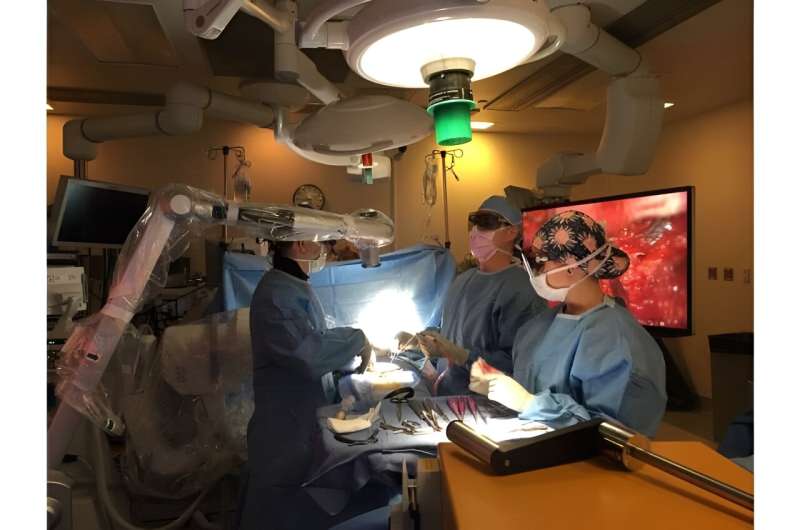This article has been reviewed according to Science X's editorial process and policies. Editors have highlighted the following attributes while ensuring the content's credibility:
fact-checked
trusted source
proofread
Researchers suggest changing gold standard of spine surgery from operative microscope to 3D exoscope

While surgeons have more commonly used the exoscope in various intracranial procedures, its use in spinal surgery has been underreported.
Researchers and neurosurgeons at the Medical University of South Carolina (MUSC) retrospectively compared the operative microscope to the 3D exoscope in a recent study published in World Neurosurgery and found better outcomes among both surgeons and patients when using the exoscope.
Stephen Kalhorn, M.D., FAANS, was the principal investigator on the study, and he says the traditional operative microscope has its limitations as a surgical tool.
With its more limited positioning options, the operative microscope often sits too close to the surgical field, and surgeons find they're prone to bumping their instruments into it throughout the procedure. With the exoscope, the high-definition 3D digital imaging device is positioned above the surgical field and out of the way. In addition to position, it also allows physicians to see a three-dimensional view of the surgical field during surgery.
Sunil Patel, M.D., the chair of neurosurgery at MUSC, points to its use in any surgery that requires magnification even though this study focused on minimally invasive spine procedures like anterior cervical decompressions and fusions.
"Including the robotic aspect of this tool," he said, "you have factors that lead to a more fluent surgery. You have fewer errors with better visualization which leads to better patient outcomes."
Neurosurgeons often perform spine procedures in positions that are not good for their posture. More than 60% of neurosurgeons report low back pain and 31% have diagnosed lumbar disc herniation, according to a study published in Acta Neurochirurgica. With its high level of magnification, better lighting and more position flexibility, the 3D exoscope allows a more natural posture during surgery, which Kalhorn says is much more comfortable and allows him to be more efficient during surgery.
Noah Nawabi, a medical student at MUSC, was the first author on the study and worked alongside Kalhorn. He says that while he can't directly connect the exoscope to more favorable clinical results, patients whose surgeons used the exoscope had significantly shorter times in the operating room as well as shorter hospital stays than those with the operative microscope.
Kalhorn and Nawabi say this could be very impactful clinically for minimally invasive spinal surgeries since the increased visualization allows for smaller incisions and less blood loss for the patient while also being more comfortable to the surgeon.
Surgical views can even be shared between multiple surgeons and residents simultaneously during surgery, making it a useful teaching tool as well. Nawabi says it has been an effective learning tool for him.
"Its ability to provide the attending surgeon's view to everyone involved in the case makes it an unmatched facilitator of observation," he said. "It helped me establish an early understanding of basic neurosurgical anatomy and approaches."
Nawabi also says the results of this study support other similar studies, but that the literature around its use for spinal surgery was lacking. These results suggest that more surgeons may wish to explore using the exoscope for their spinal surgeries in the future.
More information: Noah L.A. Nawabi et al, Intraoperative Performance with the Exoscope in Spine Surgery: An Institutional Experience, World Neurosurgery (2023). DOI: 10.1016/j.wneu.2023.12.004




















